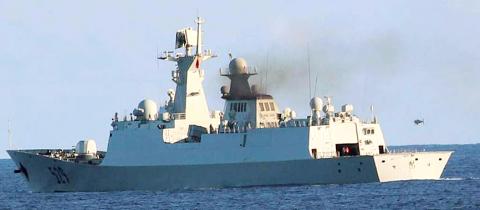Pictures released earlier this week by the Japan Maritime Self-Defense Force (JMSDF) showing mysterious unmanned aerial vehicles (UAV) hovering above and parked on the rear landing deck of a Chinese frigate at sea have left defense analysts scratching their heads.
The pictures, first published by Japanese media on Wednesday, were taken while three People’s Liberation Army Navy vessels — the Type 054A missile frigates Zhoushan and Xuzhou, and the electronic reconnaissance and missile tracking Beijixing — conducted exercises in the West Pacific, about 700km off Japan’s Okinotori.
A Japanese surveillance aircraft spotted the vessels on April 29 as they crossed from the East China Sea into the strait of Osumi, the first such crossing by PLAN vessels in nine years. The ships were again spotted on their return journey on Monday.

Photo courtesy of the Japan Maritime Self Defense Force
Aside from the rare crossing in a channel usually used by the US 7th Fleet, what mystified defense enthusiasts were two pictures released by the JMSDF, one showing three unmanned helicopters on the platform of the Zhoushan and another showing a similar type of UAV hovering above the vessel.
The People’s Liberation Army has a longstanding interest in UAV technology, and several civilian and military firms, including Aviation Industry Corp of China (AVIC), have been working on a variety of models. However, China has yet to confirm the successful development of an unmanned helicopter that is heavy enough and capable of vertical takeoff and landing (VTOL) at sea, where runways are in short supply.
Very few models worldwide have demonstrated the capability so far. One of them, the Camcopter S-100s, built by Austrian firm Schiebel Corp, held a successful trial at sea last month on board an Italian naval ship.
According to analysts, the UAVs seen on the Zhoushan bear a striking resemblance to the S-100. The S-100 was showcased at the Fourth China International Exhibition on Police and Anti-Terrorism Technology and Equipment Exhibition held in Beijing in April last year, and defense-related Chinese Web sites have paid close attention to the device.
Rumors have circulated in defense circles that China may have placed orders for several S-100s. Although the EU has an arms embargo on China, the rules appear to have been relaxed in recent years, limiting exports to purely defensive platforms.
Foreign clients of the S-100 include Germany, the United Arab Emirates, Libya and South Korea, which experienced a crash in Incheon on May 11, killing one person. Pakistan has also expressed interest in acquiring the UAV.
Another possibility raised by some experts is that Chinese firms reverse-engineered the S-100, as they have often done with foreign technology.
One model, China’s Sunward Tech Star-lite SVU200, which conducted its maiden flight on land recently, looks very similar to the S-100. However, Greg Waldron of Flight Global, who attended the Beijing Air Show in September, where the SVU200 was showcased, told the Taipei Times the manufacturer had not mentioned sea capabilities for the aircraft.
Unmanned vehicles can serve a number of military purposes, including electro-optic surveillance, reconnaissance, target acquisition radar and transmission relay.
Such capabilities substantially increase a navy’s ability to monitor and control its surroundings. Larger models can also carry a variety of missiles.

A car bomb killed a senior Russian general in southern Moscow yesterday morning, the latest high-profile army figure to be blown up in a blast that came just hours after Russian and Ukrainian delegates held separate talks in Miami on a plan to end the war. Kyiv has not commented on the incident, but Russian investigators said they were probing whether the blast was “linked” to “Ukrainian special forces.” The attack was similar to other assassinations of generals and pro-war figures that have either been claimed, or are widely believed to have been orchestrated, by Ukraine. Russian Lieutenant General Fanil Sarvarov, 56, head

SAFETY FIRST: Double the number of police were deployed at the Taipei Marathon, while other cities released plans to bolster public event safety Authorities across Taiwan have stepped up security measures ahead of Christmas and New Year events, following a knife and smoke bomb attack in Taipei on Friday that left four people dead and 11 injured. In a bid to prevent potential copycat incidents, police deployments have been expanded for large gatherings, transport hubs, and other crowded public spaces, according to official statements from police and city authorities. Taipei Mayor Chiang Wan-an (蔣萬安) said the city has “comprehensively raised security readiness” in crowded areas, increased police deployments with armed officers, and intensified patrols during weekends and nighttime hours. For large-scale events, security checkpoints and explosives

A magnitude 7.0 earthquake struck off Yilan at 11:05pm yesterday, the Central Weather Administration (CWA) said. The epicenter was located at sea, about 32.3km east of Yilan County Hall, at a depth of 72.8km, CWA data showed There were no immediate reports of damage. The intensity of the quake, which gauges the actual effect of a seismic event, measured 4 in Yilan County area on Taiwan’s seven-tier intensity scale, the data showed. It measured 4 in other parts of eastern, northern and central Taiwan as well as Tainan, and 3 in Kaohsiung and Pingtung County, and 2 in Lienchiang and Penghu counties and 1

‘POLITICAL GAME’: DPP lawmakers said the motion would not meet the legislative threshold needed, and accused the KMT and the TPP of trivializing the Constitution The Legislative Yuan yesterday approved a motion to initiate impeachment proceedings against President William Lai (賴清德), saying he had undermined Taiwan’s constitutional order and democracy. The motion was approved 61-50 by lawmakers from the main opposition Chinese Nationalist Party (KMT) and the smaller Taiwan People’s Party (TPP), who together hold a legislative majority. Under the motion, a roll call vote for impeachment would be held on May 19 next year, after various hearings are held and Lai is given the chance to defend himself. The move came after Lai on Monday last week did not promulgate an amendment passed by the legislature that